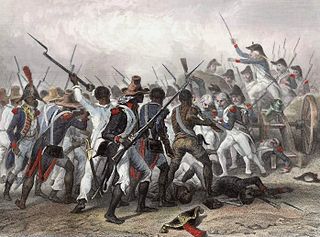
United States v. Schooner Amistad, 40 U.S. 518 (1841), was a United States Supreme Court case resulting from the rebellion of Africans on board the Spanish schooner La Amistad in 1839. It was an unusual freedom suit that involved international diplomacy as well as United States law. The historian Samuel Eliot Morison described it in 1969 as the most important court case involving slavery before being eclipsed by that of Dred Scott v. Sandford in 1857.

The Middle Passage was the stage of the Atlantic slave trade in which millions of enslaved Africans were transported to the Americas as part of the triangular slave trade. Ships departed Europe for African markets with manufactured goods, which were then traded for slaves with rulers of African states and other African slave traders. Slave ships transported the slaves across the Atlantic. The proceeds from selling slaves were then used to buy products such as furs and hides, tobacco, sugar, rum, and raw materials, which would be transported back to Europe to complete the triangle.

Triangular trade or triangle trade is trade between three ports or regions. Triangular trade usually evolves when a region has export commodities that are not required in the region from which its major imports come. It has been used to offset trade imbalances between different regions.
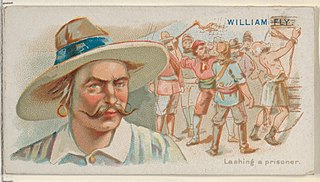
William Fly was an English pirate who raided New England shipping fleets for three months in 1726 until he was captured by the crew of a seized ship. He was hanged in Boston, Massachusetts and his body publicly exhibited as a warning to other pirates. His death is considered by many to mark the end of the Golden Age of Piracy.

Sengbe Pieh, also known as Joseph Cinqué or Cinquez and sometimes referred to mononymously as Cinqué, was a West African man of the Mende people who led a revolt of many Africans on the Spanish slave ship La Amistad in July 1839. After the ship was taken into custody by the US Revenue-Marine, Cinqué and his fellow Africans were eventually tried for mutiny and killing officers on the ship, in a case known as United States v. The Amistad. This reached the U.S. Supreme Court, where Cinqué and his fellow Africans were found to have rightfully defended themselves from being enslaved through the illegal Atlantic slave trade and were released. The US government did not provide any aid to the acquitted Mende People. The United Missionary Society, a black group founded by James W.C. Pennington, helped raise money for the return of thirty-five of the survivors to Sierra Leone in 1842.
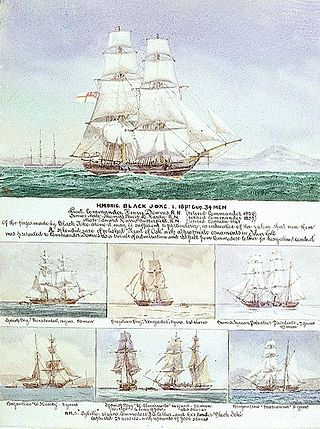
The West Africa Squadron, also known as the Preventative Squadron, was a squadron of the British Royal Navy whose goal was to suppress the Atlantic slave trade by patrolling the coast of West Africa. Formed in 1808 after the British Parliament passed the Slave Trade Act 1807 and based out of Portsmouth, England, it remained an independent command until 1856 and then again from 1866 to 1867.

Slave ships were large cargo ships specially built or converted from the 17th to the 19th century for transporting slaves. Such ships were also known as "Guineamen" because the trade involved human trafficking to and from the Guinea coast in West Africa.

The Golden Age of Piracy is a common designation for the period between the 1650s and the 1730s, when maritime piracy was a significant factor in the histories of the North Atlantic and Indian Oceans.
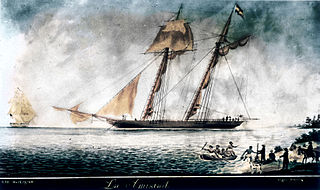
La Amistad was a 19th-century two-masted schooner owned by a Spaniard living in Cuba. It became renowned in July 1839 for a slave revolt by Mende captives who had been captured and sold to European slave traders and illegally transported by a Portuguese ship from West Africa to Cuba, in violation of European treaties against the Atlantic slave trade. Spanish plantation owners Don José Ruiz and Don Pedro Montes bought 53 captives in Havana, Cuba, including four children, and were transporting them on the ship to their plantations near Puerto Príncipe. The revolt began after the schooner's cook jokingly told the slaves that they were to be "killed, salted, and cooked." Sengbe Pieh unshackled himself and the others on the third day and started the revolt. They took control of the ship, killing the captain and the cook. Three Africans were also killed in the melee.

Benjamin Lay was an English-born writer, farmer and activist. Born in Copford, Essex into a Quaker family, he was initially underwent an apprenticeship as a glovemaker before running away to London and finding work as a sailor. In 1718, Lay moved to the British colony of Barbados, which operated on a plantation economy dependent on slave labour. While working as a merchant, his shock at the brutal treatment of slaves in Barbados led Lay to develop lifelong abolitionist principles, which were reinforced by his humanitarian ideals and Quaker beliefs.
Lomboko was a slave factory in what is today Sierra Leone, controlled by the infamous Spanish slave trader Pedro Blanco. It consisted of several large depots or barracoons for slaves brought from the interior, as well as several palatial buildings for Blanco to house his wives, concubines, and employees.

Peter Linebaugh is an American Marxist historian who specializes in British history, Irish history, labor history, and the history of the colonial Atlantic. He is a member of the Midnight Notes Collective.

The Battle of Fort Mose was a significant action of the War of Jenkins' Ear that took place on June 14, 1740 in Spanish Florida. Captain Antonio Salgado commanded a Spanish column of 300 regular troops, backed by the free black militia under Francisco Menéndez and allied Seminole warriors consisting of Indian auxiliaries. They stormed Fort Mose, a strategically crucial position newly held by 170 British soldiers under Colonel John Palmer. Palmer and his garrison had taken the fort from the Spanish as part of James Oglethorpe's offensive to capture St. Augustine.
The distribution of justice was a practice commonly adopted by pirates. Ships operated as limited democracies and imposed their ideas of justice upon the crew of the ship that they captured. After capture, the crew would be questioned as to whether they had suffered cruel or unjust treatment from the commander of the ship. Any commanders "against whom Complaint was made" would be punished or even executed. This punishment was not indiscriminately given to all ships' commanders. An "honest Fellow that never abused any Sailors" would be rewarded, and sometimes freed.

The Atlantic World refers to the period between European colonisation of the Americas (1492-) and the early nineteenth century. Piracy became prevalent in this era because of the difficulty of policing this vast area, the limited state control over many parts of the coast and the competition between different European powers. The best known pirates of this era are the Golden Age pirates (c.1650-1730) who roamed the seas off the coast of North America, Africa and the Caribbean.
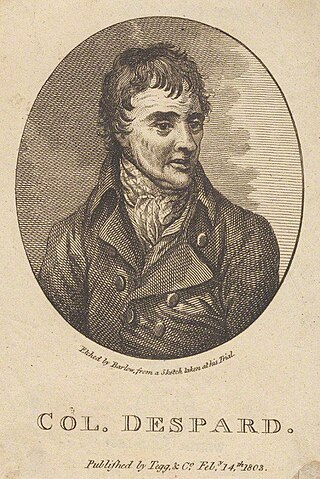
The Despard Plot was a failed 1802 conspiracy by British revolutionaries led by Colonel Edward Marcus Despard, a former army officer and colonial official. Evidence presented in court suggested that Despard planned to assassinate the monarch George III and seize key strong points in London such as the Bank of England and Tower of London as a prelude to a wider uprising by the population of the city. The British Government was aware of the plot five months before the scheduled date of attack, but waited to arrest to gain enough evidence. One week before the scheduled attack, Despard and his co-conspirators were arrested at the Oakley Arms pub in Lambeth on suspicion of plotting an uprising. Despard's execution on 21 February 1803 was attended by a crowd of around 20,000, the largest public gathering until the funeral of Lord Nelson two years later following the Battle of Trafalgar.

Inhuman Bondage: The Rise and Fall of Slavery in the New World is a book by American cultural and intellectual historian David Brion Davis, published by Oxford University Press in 2006. It recounts the history of slavery in a global context. It was praised widely as a full and comprehensive rendering of the subject and won the 2007 Ralph Waldo Emerson Award.

Hydrarchy, is the organizational structure of a ship, or the ability for individual(s) to gain power over land by ruling through the instrument of water, as defined by English poet Richard Braithwaite (1588-1673), who coined the term.
Dinah Black, also known as Dinah the Moor and Dinah the Black, was a Black woman who lived in the English city of Bristol during the 17th century and was baptised as a Christian. Though historical information on her life is scarce, records show that she visited Baptist spiritualist Sarah Wight in London in 1647 and appeared in a case heard by the Bristol Court of Aldermen in July 1667 after escaping from a ship which was supposed to transport her to a plantation overseas.
Captain Tomba was an African ruler who was sold into slavery during the 18th century.























